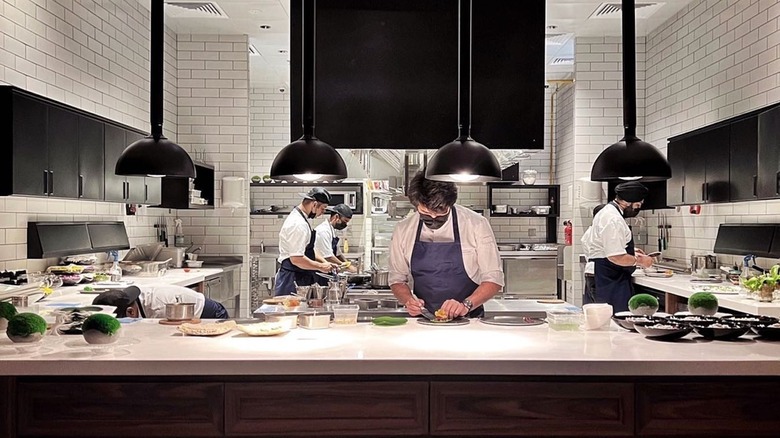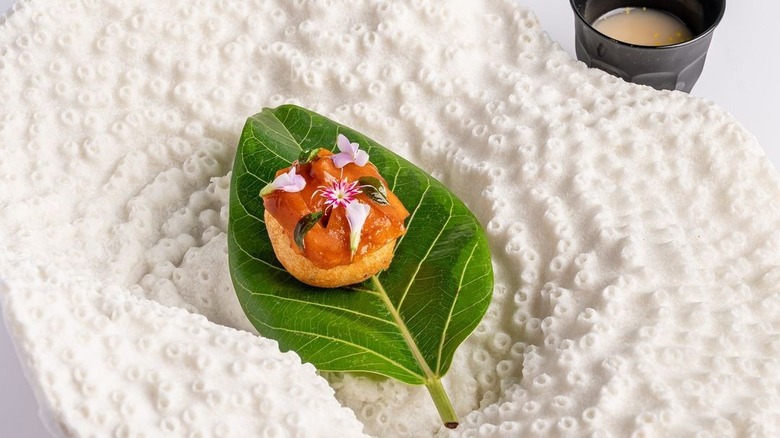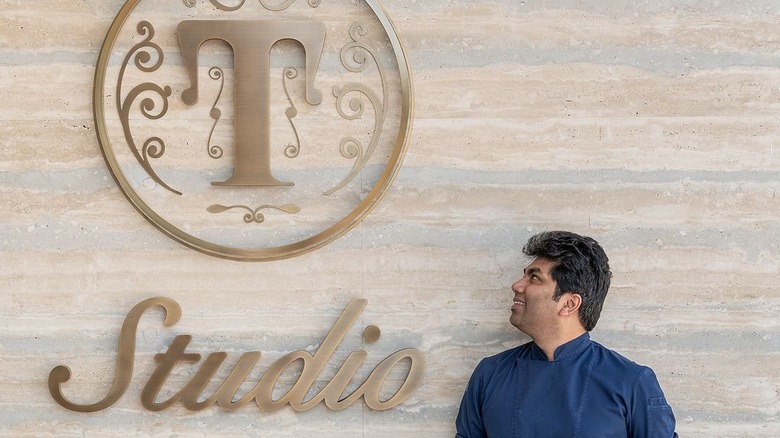Dubai's Trèsind Studio Restaurant Aims To Challenge Common Views On Indian Cuisine
Culturally and architecturally, Dubai blends the old with the new — so why should its food scene do any less? Trèsind Studio, a restaurant on The Palm Jumeirah, led by chef Himanshu Saini, reflects just that. In his early thirties, Saini is considered a young tastemaker, and builds upon the legacies and traditions of regional cuisines across India, the country he calls home. The chef brings Indian dishes to Dubai in a striking way, with exquisitely ornate and delicate dishes that tell stories of where they originated from. That, along with its emphasis on hospitality, is what has put Trèsind Studio on the 50 Best Restaurants of The World list — namely as the Best Restaurant in North Africa and the Middle East — as well as what secured it its second Michelin star in 2023.
Born as a chef's-table style concept in a room adjacent to the original Trèsind in the One&Only Royal Mirage hotel, Trèsind Studio opened on top of the Nakheel Mall in May 2022 to highlight Himanshu Saini's talent. With seating for just 20 guests, the space is intimate, allowing tables a front-line view into the open kitchen where the chef and his accomplices take center stage. The menu is divided into regions of India with the food in each section reflective of the area, but elevated into exceptional tastes of each source dish. Diners become immersed on a trip through the country while eating, the experience growing more entrancing as each course arrives.
A journey through India
Although Himanshu Saini believes that Indian food is ever-evolving, the vision for Trèsind Studio's menu was to tell the story of India — and deliver it in a way that challenges stereotypes of Indian food. Composed of four courses, each built upon four dishes from India's four major geographical regions: the Thar desert, Deccan plateau, coastal plains and islands, and the Northern plains and Himalayan mountains, the Trèsind Studio menu displays the country's rich and diverse food identity. Yet, even without the rice, tandoor-cooked dishes, or biryani which one might expect on an Indian food menu, the rich food culture runs through it.
One example of that is a dish called sadya, inspired by a celebratory meal of various vegetarian delights served on a banana leaf in Kerala during the first harvest season. Eaten during the second course here at Trèsind Studio (in the Deccan plateau region section), chef Saini's version breaks the sadya down into a more simplified affair. However, a component of each of the 25 dishes is still present and plated one by one in front of the diner. Growing up in an agricultural family in Old Dehli, chef Saini says that the sadya holds a special place in his heart. "For me, it is symbolic of community bonding and represents the true spirit of Indian culture," he says. "We intend to bring out the same emotions of a sadya. It has had an emotional impact on some of our guests."
Street food and the future of Indian cuisine
"Our food philosophy is rather simple," says Himanshu Saini. "We love to create dishes we would love to eat or something we have grown up eating, and street food is at the heart of our memories." Coming from Old Dehli, where street food is deeply rooted in the local culture, Saini, and his team, have found ways to elevate the foods they're most fond of — from kebabs to pani puri and chaats. "Dubai is a melting pot of cultures, so we have an advantage here to get as creative as we can in terms of ingredients and flavors," he explains. Every time they change the menu, they change up the flavors of the pani puri and chaats — the most popular being the pumpkin chaat.
Of course, that all goes hand in hand with Trèsind Studio's larger mission, which is representing the sheer diversity of Indian cuisine. "It was one of my trips to Europe that was a wake-up call for me," says Saini. "When I was addressing a panel and speaking about Indian food, I realized the majority of the audience couldn't even name five Indian dishes. We dive into these geographical landscapes to introduce how diverse Indian food is depending on their climatic and social conditions, cultural influences that have for hundreds of years shaped what we commonly eat today." Looking forward, Saini believes Indian cuisine will only continue to evolve and give voice to that rich heritage.


